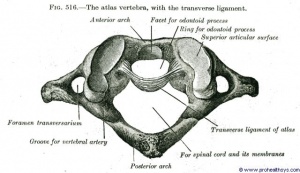Transverse Ligament Stress Test: Difference between revisions
Tamara Eller (talk | contribs) No edit summary |
Tamara Eller (talk | contribs) No edit summary |
||
| Line 18: | Line 18: | ||
== Technique <ref>↑ Dutton, M. (2008). Orthopaedic: Examination, evaluation, and intervention (2nd ed.). New York: The McGraw-Hill Companies, Inc.</ref> == | == Technique <ref>↑ Dutton, M. (2008). Orthopaedic: Examination, evaluation, and intervention (2nd ed.). New York: The McGraw-Hill Companies, Inc.</ref> == | ||
[[Image:Gray516.jpg|thumb|right.]] | [[Image:Gray516.jpg|thumb|right.]] | ||
*The patient is placed in a supine postion with the Therapist supporting the patient's head with the palms and 3rd-5th fingers. | *The patient is placed in a supine postion with the Therapist supporting the patient's head with the palms and 3rd-5th fingers. | ||
| Line 24: | Line 24: | ||
*The Therapist then lifts the patients head and C1 vetebra anteriorly, without allowing flexion or extension. | *The Therapist then lifts the patients head and C1 vetebra anteriorly, without allowing flexion or extension. | ||
*The position should be held for 10-20 seconds. | *The position should be held for 10-20 seconds. | ||
*A positive test is the reoccurance of symptoms. | *A positive test is the reoccurance of symptoms. | ||
== Evidence == | == Evidence == | ||
Revision as of 18:39, 2 June 2009
Be the first to edit this page and have your name permanently included as the original editor, see the editing pages tutorial for help.
|
Original Editor - Your name will be added here if you created the original content for this page. Lead Editors - Your name will be added here if you are a lead editor on this page. Read more. |
Purpose
[edit | edit source]
Test for hypermobility of the atlantoaxial articulation.
Technique [1][edit | edit source]
- The patient is placed in a supine postion with the Therapist supporting the patient's head with the palms and 3rd-5th fingers.
- The Therapist then places the index fingers between the occiput and spinous process of C2, so the index fingers are over the neural arch of the C1 vetebra.
- The Therapist then lifts the patients head and C1 vetebra anteriorly, without allowing flexion or extension.
- The position should be held for 10-20 seconds.
- A positive test is the reoccurance of symptoms.
Evidence[edit | edit source]
Provide the evidence for this technique here
Resources[edit | edit source]
add any relevant resources here
References
[edit | edit source]
- ↑ ↑ Dutton, M. (2008). Orthopaedic: Examination, evaluation, and intervention (2nd ed.). New York: The McGraw-Hill Companies, Inc.







